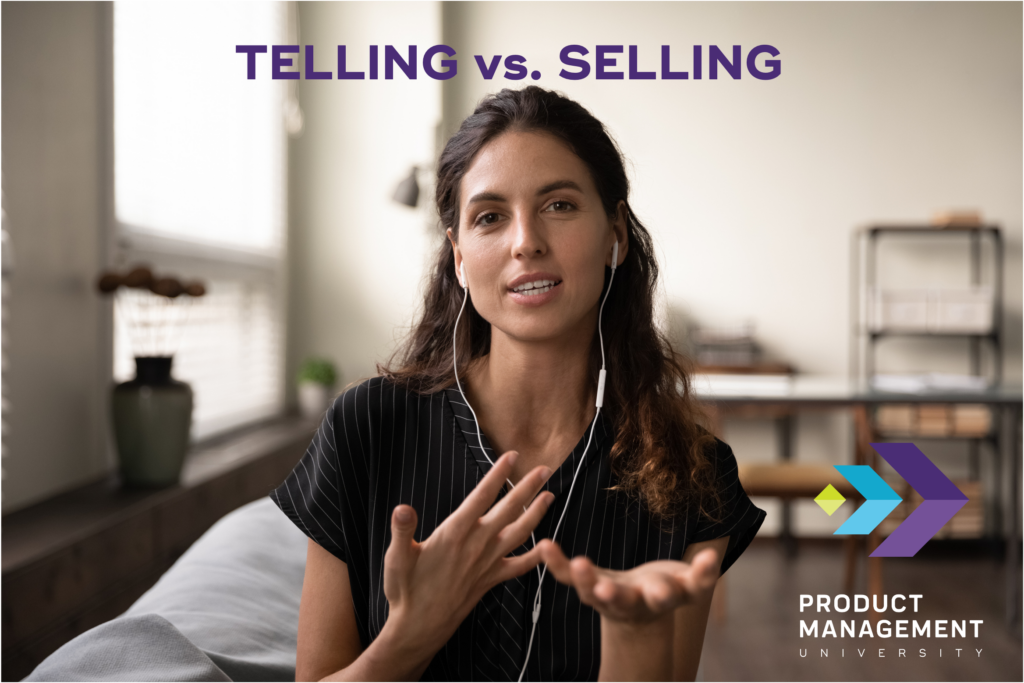Product Demos: Avoiding the Trap of Telling vs. Selling

If you’re a pre-sales solution consultant or sales engineer, falling into the trap of telling vs selling can happen before you know it, even though your intentions are always on the mark to start the demo. Here’s how to avoid the trap.
The Difference Between Telling and Selling Demos
Telling Demos
The telling demo is an overview of the product section by section, a demonstration of the features in each, and an explanation of how those features work and the benefits. The telling demos are more like an introductory training class on the product versus a sales presentation.
Telling demos aren’t going to energize anyone. They usually end with, “Thanks for the very informative demo. We’ll call you if we have any questions.” It’s one of the biggest reasons buyers go radio silent after a demo. You’re probably not going to make the shortlist and it’s easier to ghost you than deliver the bad news.
Selling Demos
The selling demo on the other hand, is an exercise in customer value themes and storytelling. You’re essentially making statements you know buyers agree with and telling stories about the real world they live in every day. Those stories set you up to show results and outcomes they’ll realize when your product obliterates their problems.
Selling demos are like therapy for buyers. They’re energizing because they make buyers feel good to know someone else understands exactly what they’re going through and why. They also create the perception your product is better than the competition, which is the whole idea behind selling demos.
If the deal is real, buyers are the ones to map out timing and next steps without prompting on your part. That’s the power of a compelling demo. It creates a greater urgency to buy.
The Trap and How to Avoid It
Your demo is cruising along according to plan, and then after you show a specific scenario, someone in the audience asks a legitimate question about how a specific feature works when there’s an exception to deal with.
As you should, you explain how the product supports the one-off scenario. The trap door is now open. You did such a great job of articulating how your product handled that one exception, more questions start rolling in about other exceptions.
If you don’t take a step back, you’re in the trap. The rest of your demo can quickly go the route of explaining HOW things work instead of WHY they’re valuable. Before you know it, your demo has shifted into reverse and you’re into a “telling” demo.
Here’s the key to avoiding the trap. You have to reverse-engineer every question back it into a user scenario of the specific job task someone is performing. Here’s an example.
“Can you explain how your system reads resumes from job applicants?”
Instead of going right into the explanation, you can do one of two things.
- If the user scenario is clear based on the context of the conversation, paraphrase the scenario and get confirmation before you explain. “So, you’ve got jobs posted and you want to know how the system is going to screen resumes to give you a shortlist of the most qualified candidates so you don’t have to review each resume, correct?”
- If the scenario isn’t clear, your move is to ask the buyer what they’re doing, the outcome they want, and why it’s difficult today.
In either case, your explanation will have full value context and keep you out of the “telling” trap.
The Bottom Line on Telling vs. Selling
Unfortunately, most demos either start or quickly fall into the “telling” category. You’ve heard all the slangs by now, feature dump, spray and pray, show up and throw up, etc. where you merely hope your audience will like more of your features than the competition.
The consequences are longer more expensive sales cycles (more demos) and fewer wins because prospects don’t understand what your product helps them accomplish and how it makes them more successful.
The “selling” demo is not about what the product does, but clearly articulates the business outcomes buyers get, why those outcomes are operationally and strategically important to their business and the obstacles eliminated in the process.
The key difference between the two styles of demos is the telling demo is all about the product while the selling demo is all about the prospect. Relevance is the key. Selling demos usually result in shorter less expensive sales cycles (fewer demos) and more wins because they keep buyers in their comfort zone!
Remember, buyers don’t buy because they understand you. They buy because they’re convinced you understand them, a lot better than the competition.
Make Every Demo a Selling Demo
If you want every sales demo to be a selling demo, contact us about a personalized Product Demo Skills workshop where you’ll learn hands-on demo techniques using your own products and get certified on your ability to do outcome-based product demos.
Click here if you want to experience the easiest way to learn product management, product marketing, pre-sales demos and customer success with our unique hands-on learning format. Be sure to check out our Product Management Framework that simplifies everything by making customer outcomes the starting point for building, marketing, selling and delivering strategic value.
You might also like:
- Solution Selling vs. Aspirational Selling
- What Makes A Memorable Product Demo And Why Is It Important?
- Nailing the Discovery Meeting
by John Mansour on March 23, 2023.